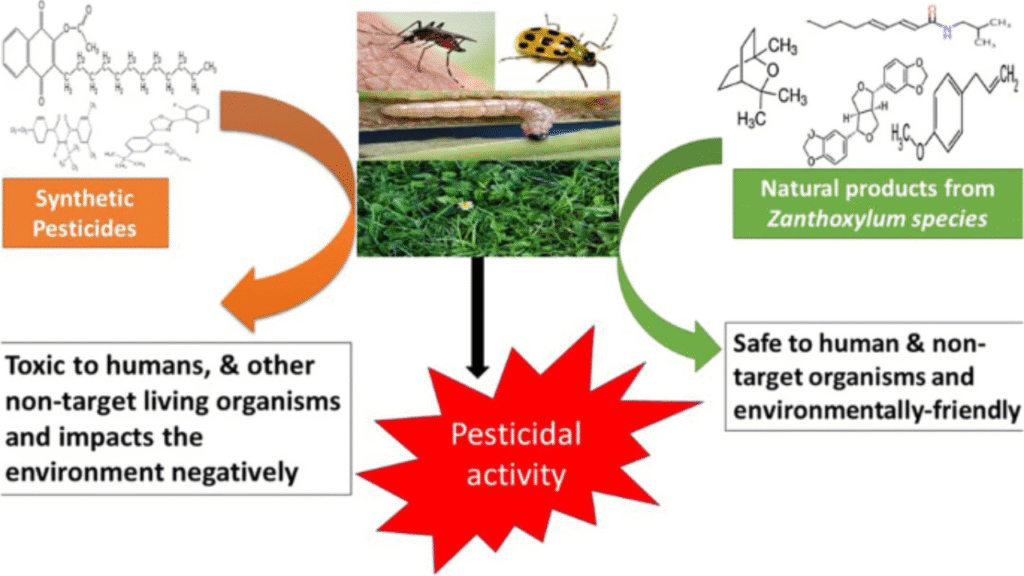
In the pursuit of more effective, eco-friendly pest control, the agricultural world is discovering a powerful truth: plant extracts work even better together. When combined, these natural compounds often produce a synergistic effect—where their combined impact is greater than the sum of their parts. This synergy improves efficacy, expands the range of target pests, and reduces the likelihood of pest resistance.
This article explores the synergistic effects of plant extracts in pest management, explaining how combinations of botanical compounds can enhance natural pest control, the science behind it, real-world applications, and practical examples.
Overview Table: Synergistic Combinations in Botanical Pest Control
| Extract Combination | Key Active Compounds | Target Pests | Mode of Synergy | Application Form | Outcome Benefit |
|---|---|---|---|---|---|
| Neem + Garlic | Azadirachtin + Allicin | Aphids, mites | Growth disruption + respiratory block | Foliar spray | Enhanced pest knockdown |
| Lemongrass + Peppermint | Citral + Menthol | Mosquitoes, flies | Olfactory confusion + repellence | Essential oil blend | Longer-lasting repellency |
| Turmeric + Ginger | Curcumin + Gingerol | Soil fungi, grubs | Enzyme inhibition + antioxidant stress | Soil drench | Stronger fungal suppression |
| Basil + Eucalyptus | Linalool + Cineole | Storage pests | Volatile inhibition + fumigation | Vapor or spray | Improved post-harvest control |
| Sweet Flag + Neem | Asarone + Azadirachtin | Caterpillars, borers | Growth regulation + feeding deterrence | Seed treatment, spray | Multi-stage pest control |
What Is Synergy in Plant-Based Pest Control?
Synergy refers to the interaction between two or more bioactive substances that results in a greater effect than when each is used alone. In botanical pest management, this often means:
- Increased potency
- Broader spectrum of action
- Faster pest suppression
- Lower required doses
- Improved crop safety
Synergistic interactions can be:
- Additive: Combined effect equals the sum of individual effects
- Potentiating: One enhances the effect of the other
- True synergistic: The combination has a new or amplified effect
How Synergistic Plant Extracts Work
1. Multiple Modes of Action
When two plants with different bioactive mechanisms are combined, they target pests from multiple angles.
Example:
- Neem (growth disruptor) + Garlic (respiratory toxin)
Result: Pests are immobilized faster and fail to reproduce.
2. Wider Pest Spectrum
Some extracts work on chewing pests, others on sucking insects. A combo can cover both.
Example:
- Lemongrass (fly deterrent) + Peppermint (mosquito repellent)
Result: Broader coverage in open field applications.
3. Reduced Resistance Risk
Pests are less likely to develop resistance to multiple active compounds acting simultaneously.
4. Lower Dosage, Higher Effectiveness
Synergy often allows reduced application rates of each extract while maintaining strong efficacy.
Real-World Applications of Synergistic Botanical Extracts
1. Neem + Garlic Against Aphids and Mites
In organic vegetable farming, neem oil (0.5%) mixed with garlic extract (1%) has shown a significant 75% reduction in aphid and mite populations within 5–7 days of application.
2. Turmeric + Ginger in Soil-Borne Disease Control
Used as a soil drench, this combination suppresses Fusarium and Rhizoctonia fungi better than either extract alone. Curcumin damages fungal enzymes while gingerol triggers oxidative stress.
3. Basil + Eucalyptus for Grain Storage
A mix of basil and eucalyptus oils creates a fumigant vapor that repels weevils and prevents fungal mold growth in stored cereals for over 30 days without residue.
Comparative Table: Individual vs. Synergistic Action
| Plant Extract(s) | Used Alone (Efficacy %) | Combined Efficacy (%) | Synergistic Outcome |
|---|---|---|---|
| Neem (Azadirachtin) | 55% | ||
| Garlic (Allicin) | 45% | ||
| Neem + Garlic | 82% | Increased mortality and repellence |
| Turmeric (Curcumin) | 50% | | |
| Ginger (Gingerol) | 48% | | |
| Turmeric + Ginger | | 79% | Faster fungal cell inhibition |
Guidelines for Using Synergistic Botanical Extracts
- Choose Compatible Extracts
Ensure the components don’t chemically neutralize each other. - Test for Phytotoxicity
Some combinations may damage sensitive plants—test on a small patch first. - Use Proper Ratios
Common synergistic ratios are 1:1 or 2:1 depending on concentration. - Ensure Freshness
Use fresh extracts or well-preserved oils to retain bioactivity. - Mix Immediately Before Use
Mixing plant extracts too early may cause degradation.
Advantages of Synergistic Botanical Pest Control
- Enhanced efficacy at lower doses
- Safer for beneficial insects and pollinators
- Broader protection from one application
- Ideal for Integrated Pest Management (IPM)
- Cost-effective for small and organic farms
Challenges in Implementation
- Formulation Stability: Oils and aqueous extracts may separate or degrade
- Standardization: Varying potency due to plant source or method of extraction
- Shelf Life Issues: Without preservatives, mixtures must be used quickly
- Knowledge Gaps: Farmers may not know effective synergistic pairings
Future Potential
Advances in plant biochemistry and formulation science are leading to commercial biopesticides based on synergistic plant extract blends. These products can match or even surpass the effectiveness of synthetic chemicals—without harming the environment or leaving residues.
As climate-resilient farming grows, customized plant extract blends tailored to local pests and crops will revolutionize eco-agriculture.
FAQs
Q1: Can I mix any two plant extracts for synergy?
No—some combinations may cancel each other out or be phytotoxic. Use tested pairings or consult agricultural guidelines.
Q2: How often should synergistic extracts be applied?
Typically every 7–10 days, but this depends on pest pressure and weather conditions.
Q3: Are synergistic plant extracts safe for all crops?
Most are safe, but it’s best to test on a small area first to check for sensitivity.

